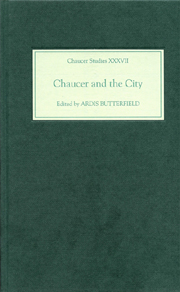Book contents
- Frontmatter
- Contents
- List of Illustrations
- Dedication
- Preface
- List of Contributors
- Abbreviations
- Map
- INTRODUCTION
- LOCATIONS
- COMMUNITIES
- 5 Chaucer and the Language of London
- 6 The Canterbury Tales and London Club Culture
- 7 London and Southwark Poetic Companies: ‘Si tost c'amis’ and the Canterbury Tales
- INSTITUTIONS
- AFTERLIVES
- Bibliography
- Index
- CHAUCER STUDIES
7 - London and Southwark Poetic Companies: ‘Si tost c'amis’ and the Canterbury Tales
from COMMUNITIES
Published online by Cambridge University Press: 05 February 2013
- Frontmatter
- Contents
- List of Illustrations
- Dedication
- Preface
- List of Contributors
- Abbreviations
- Map
- INTRODUCTION
- LOCATIONS
- COMMUNITIES
- 5 Chaucer and the Language of London
- 6 The Canterbury Tales and London Club Culture
- 7 London and Southwark Poetic Companies: ‘Si tost c'amis’ and the Canterbury Tales
- INSTITUTIONS
- AFTERLIVES
- Bibliography
- Index
- CHAUCER STUDIES
Summary
The narrative frame that Chaucer chooses for the Book of the Tales of Caunterbury, as the Hengwrt manuscript heads the work, is only intermittently about a pilgrimage to Canterbury. It is a collection of stories, a ‘book of tales’, set in motion by the Host's suggestion at the end of the General Prologue that the journey should become the opportunity for a competition, with a reward for the winner:
And which of yow that bereth hym best of alle –
That is to seyn, that telleth in this caas
Tales of best sentence and moost solaas –
Shal have a soper at oure aller cost
Heere in this place. (I, 796–800)
Harry, it appears, is to be the arbiter, both of the contest and of any arguments that take place along the way, with a severe financial penalty for anyone who objects. From this moment on, the pilgrimage is relegated to the background, even in most of the links, to be replaced by something like a fourteenth-century Man Booker Prize – or perhaps, since most of the tales (as it is too easy to overlook) are in verse, a T. S. Eliot Prize.
The very modernity of such a scenario is perhaps one reason why it has been backstaged in much Chaucer criticism. The nineteenth-century scholars who largely established the parameters of the critical tradition had to look back to Athenian drama or Theocritus-influenced eclogues to find poetic contests, but they regarded the naturalistic novel as the highest development of fiction; their emphasis on the pilgrimage over the competition followed inevitably.
- Type
- Chapter
- Information
- Chaucer and the City , pp. 109 - 126Publisher: Boydell & BrewerPrint publication year: 2006

